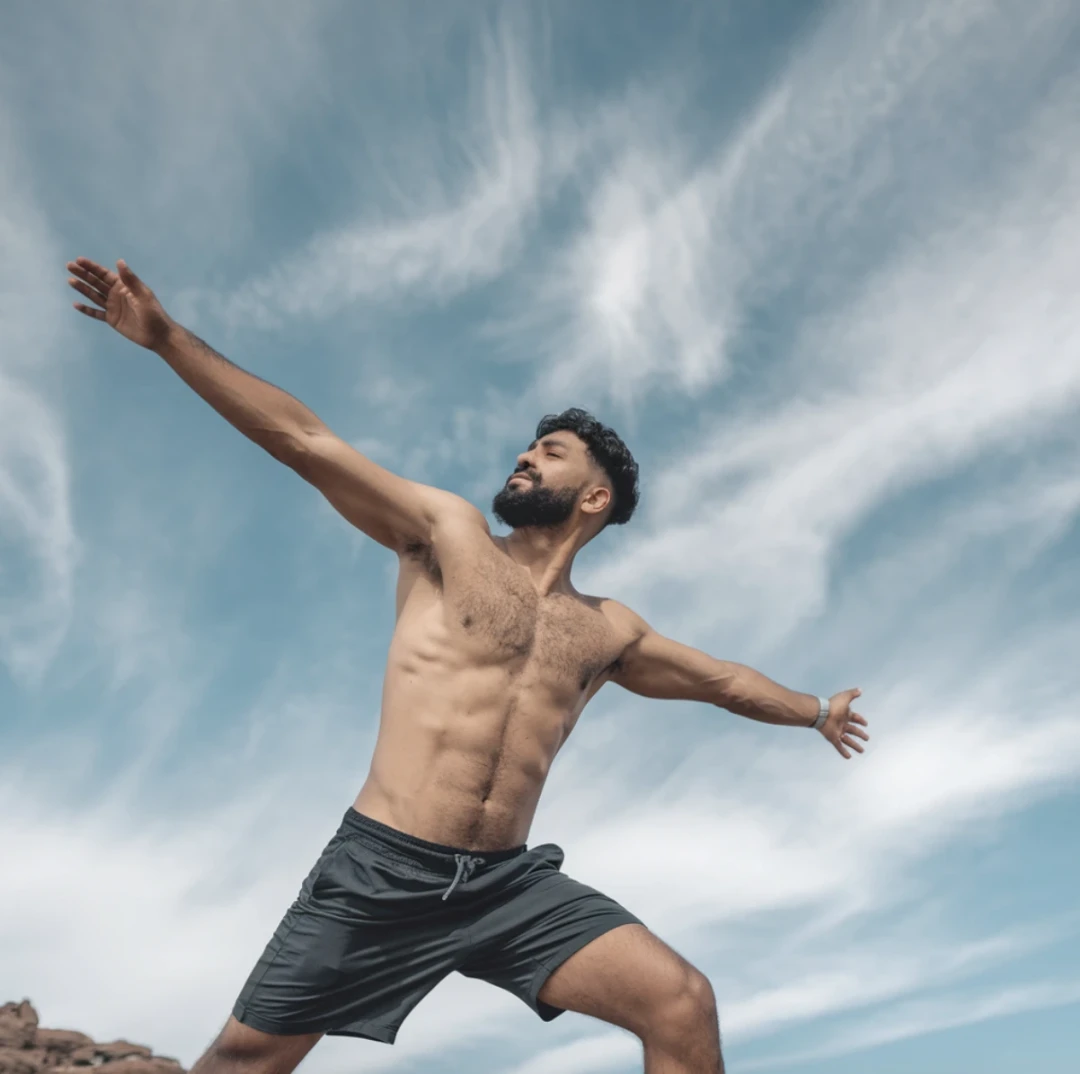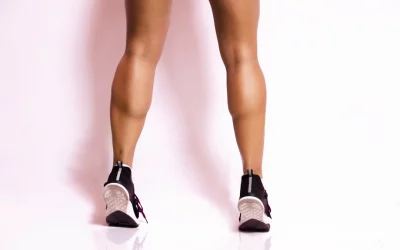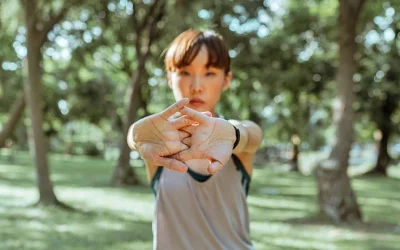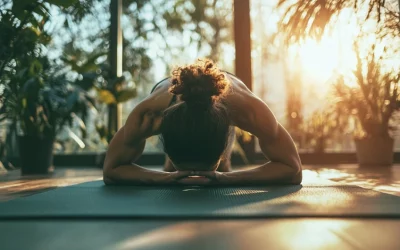Every morning is your chance to start fresh—so why not kick it off with a stretch? Quick, easy, and gear-free, stretching isn’t just about waking up your body; it’s like a mini-reboot for your soul. It loosens you up, gets the blood flowing, and sets a vibrant tone for the day ahead. Think of it as your morning coffee but for your muscles!
This article explores the substantial health benefits of incorporating morning stretches into your routine. Embracing this practice boosts not only your immediate wakefulness but also lays the foundation for long-term health and well-being.
Keep reading to learn how to stretch your way into brighter mornings—because why settle for groggy starts when you can spring into action with ease and grace?
Benefits of a Daily Stretch Routine
Engaging in a daily stretch routine not only prepares your body for the day’s challenges but also improves your overall health and athletic performance. Regular stretching significantly improves flexibility, which directly correlates with a reduced risk of injuries, especially those related to muscles and joints.
By maintaining flexible muscles and tendons, you’re less likely to experience strains and sprains during everyday activities or more intense physical exertions. Stretching also plays a crucial role in improving posture and balance, which can contribute to better body alignment and a decrease in discomfort, particularly in areas prone to strain like the lower back.
For athletes, the benefits extend into better performance, as a well-stretched muscle has a greater range of motion and efficiency. Embrace this simple practice to strengthen your body’s resilience and boost both physical and mental vitality.
To make stretching a consistent habit that supports your long-term well-being, consider integrating technology that tracks your progress. Apps like WeStretch offer personalized stretching routines and allow you to monitor improvements, helping you maintain a commitment to enhancing your flexibility and health every day.
Dynamic Stretches
Arm Circles
The Arm Circle is a vital dynamic stretch that targets the mobility and flexibility of the shoulder joints, essential for upper body activities and exercises. By rotating the arms in controlled circles, this stretch effectively warms up the shoulders, preparing them for more rigorous movements.
This stretch is especially beneficial as it helps:
-
Enhance blood circulation around the shoulders.
-
Increase the range of motion and flexibility of the shoulder joints.
-
Minimize the risk of strains and injuries in the shoulder area.
To perform the Arm Circles, follow these steps:
-
Stand with your feet shoulder-width apart.
-
Extend your arms out to the sides at shoulder height. Begin by slowly rotating your arms forward in small circles, gradually increasing the size of the circles.
-
Continue this motion for up to 30 seconds, then reverse the direction and continue for another 15 seconds.
-
Ensure to keep your posture upright and your movements controlled to maximize the stretch’s effectiveness.
Leg Swings
The Leg Swing is an essential dynamic stretch that targets the flexibility and mobility of the hips and legs, vital for activities that involve lower body movement. By swinging the legs in a controlled manner, this stretch effectively loosens the hip flexors and leg muscles, preparing them for more intense physical activities.
This stretch is particularly beneficial as it helps:
-
Increase the range of motion in the hip joints.
-
Prepare the muscles for strenuous activities.
-
Improve overall leg and hip flexibility.
To perform Leg Swings, follow these steps:
-
Stand next to a wall or chair for support.
-
Swing one leg forward and backward in a controlled motion without forcing the leg too high.
-
Continue this motion for 10 swings per leg, then switch to the other leg.
-
Maintain an upright posture throughout the exercise to ensure effectiveness and prevent any potential strain.
High Knees
High Knees are a dynamic exercise designed to elevate the heart rate and enhance mobility in the lower body, making them ideal for priming muscles before engaging in cardiovascular exercises. This activity involves a high-intensity knee lift that activates multiple muscle groups.
This exercise is particularly beneficial as it helps:
-
Activate the core muscles.
-
Improve coordination, which is essential for running and dynamic movements.
-
Increase heart rate, contributing to cardiovascular health.
To perform High Knees, follow these steps:
-
Stand with your feet hip-width apart.
-
Begin to jog in place, lifting your knees as high as possible towards your chest. Use your arms to help drive your legs higher.
-
Continue this exercise for up to 30 seconds, focusing on maintaining a quick pace with high knee lifts.
-
Keep your back straight and core engaged throughout the exercise to maximize benefits and prevent injuries.
Jumping Jacks
Jumping Jacks are an effective full-body warm-up exercise that enhances cardiovascular fitness and prepares all major muscle groups for more intensive physical activity. This dynamic movement not only elevates the heart rate but also engages multiple muscles simultaneously.
This exercise is especially beneficial as it helps:
-
Enhance aerobic capacity, improving overall cardiovascular health.
-
Increase agility and coordination, vital for various sports and physical activities.
-
Stimulate all major muscle groups, ensuring they are ready for further exercise.
To perform Jumping Jacks, follow these steps:
-
Stand with your feet together and arms at your sides.
-
Explosively jump to spread your legs wide while simultaneously raising your arms above your head.
-
Quickly reverse the movement, bringing your legs back together and arms to your sides.
-
Perform this movement for 20 repetitions.
Torso Twists
Torso Twists are a crucial dynamic stretch aimed at warming up the spine and core muscles, which are fundamental for any movements involving twisting or bending. This exercise helps prepare the body for activities that require flexibility and strength in the midsection.
This stretch is particularly beneficial as it helps:
-
Increase spinal mobility, facilitating a wider range of motion.
-
Alleviate stiffness in the back, promoting comfort during movement.
-
Enhance core engagement, crucial for stability and performance in various sports and activities.
To perform Torso Twists, follow these steps:
-
Starting Position: Stand with your feet shoulder-width apart and knees slightly bent.
-
Movement: Extend your arms out to the sides at shoulder height. Twist your torso to the right as far as is comfortable, then rotate to the left, keeping your hips facing forward.
-
Duration: Continue alternating sides for up to 30 seconds, focusing on the rotation coming from your midsection and maintaining controlled movements.
Cat-Cow Stretch
The Cat-Cow Stretch is a dynamic exercise that enhances spinal flexibility and eases tension throughout the torso and neck. This gentle flow between two poses helps to improve posture and mobility in the spine.
This stretch is especially beneficial as it helps:
-
Increase spinal flexibility and ease stiffness.
-
Stimulate and massage the spine and abdominal organs.
-
Promote relaxation and stress relief by focusing on deep, rhythmic breathing.
To perform the Cat-Cow Stretch, follow these steps:
-
Begin on all fours in a tabletop position with your wrists aligned under your shoulders and your knees under your hips.
-
Inhale as you arch your back downward, lifting your head and tailbone towards the ceiling (Cow Pose). Exhale as you round your spine towards the ceiling, tucking your head towards your chest (Cat Pose).
-
Continue this fluid movement between Cow and Cat poses for 1-2 minutes, focusing on smooth transitions and deep breaths.
Incorporating these dynamic stretches into your daily routine can significantly enhance your flexibility, mobility, and overall physical readiness, setting a solid foundation for any physical activity and reducing the risk of injury.
Static Stretches
Hamstring Stretch
The Hamstring Stretch is an essential exercise aimed at improving lower body flexibility, with a particular focus on the hamstrings. This stretch helps in lengthening these muscles, which are crucial for a range of physical activities.
This stretch is notably beneficial as it helps:
-
Lengthen the hamstring muscles, promoting increased flexibility.
-
Enhance mobility and range of motion in the lower body.
-
Reduce the risk of lower back pain by alleviating tension in the hamstrings.
To perform the Hamstring Stretch, follow these steps:
-
Sit on the ground with one leg extended straight in front and the other leg bent. Rest the foot of the bent leg against the inner thigh of the straight leg.
-
Lean forward gently from the hips towards the foot of the straight leg, keeping your back straight to avoid rounding.
-
Hold the stretch for up to 30 seconds, feeling a deep stretch in the hamstring of the straight leg. Switch legs and repeat the process to ensure balance in flexibility.
Chest Opener
The Chest Opener is a vital stretch that targets the upper body, specifically the chest and shoulders. This exercise is pivotal for anyone who spends long hours sitting or in front of a computer, as it helps relieve built-up tension and promote better posture.
This stretch is particularly effective because it helps:
-
Relieve tension and tightness in the chest and shoulders.
-
Enhance respiratory function by opening up the chest area.
-
Improve posture and alignment of the upper body.
To perform the Chest Opener, follow these steps:
-
Stand or sit with your hands clasped behind your back. Ensure your spine is aligned and your shoulders are relaxed.
-
Straighten your arms to gently lift your clasped hands upwards. Simultaneously, expand your chest forward and upward, focusing on the stretch across your chest and shoulders.
-
Hold this position for up to 30 seconds, taking deep breaths to help deepen the stretch and increase its effectiveness.
Child’s Pose
The Child’s Pose is a restorative stretch that focuses on relaxing and lengthening the back while also stretching the hips and thighs. It is commonly used in yoga as a moment of rest and reflection, making it ideal for reducing stress and fatigue.
This stretch is particularly beneficial as it helps:
-
Stretch and release tension in the spine, hips, and thighs.
-
Calm the mind and lower stress levels.
-
Promote deep relaxation and improve breathing capacity.
To perform the Child’s Pose, follow these steps:
-
Kneel on the floor, touch your big toes together behind you, and sit back on your heels.
-
Separate your knees about hip-width apart. Exhale and lay your torso down between your thighs with your arms extended forward, palms facing down.
-
Hold the position for up to 30 seconds. Focus on deep, slow breathing to enhance the calming effect and increase the stretch’s benefits.
Calf Stretch
The Calf Stretch is designed to enhance flexibility in the lower legs and prevent stiffness, particularly in the calf muscles. This stretch is crucial for maintaining mobility and preventing injuries in the lower legs.
This stretch is particularly beneficial as it helps:
-
Reduce the risk of calf and Achilles tendon injuries.
-
Increase the flexibility and mobility of the ankle and calf muscles.
-
Improve blood circulation in the lower legs.
To perform the Calf Stretch, follow these steps:
-
Stand facing a wall with one foot in front of the other, about an arm’s length away.
-
Keep the back leg straight and the heel firmly on the ground. Bend the front leg and lean forward, pushing gently against the wall until you feel a stretch in the calf of the back leg.
-
Hold the stretch for up to 30 seconds, focusing on a deep stretch in the calf muscles. Then switch legs and repeat on the other side.
Including these static stretches in your cooldown routine helps your body recover from activity and prepares it for the next workout, ensuring continued flexibility and mobility. Regularly performing these stretches can significantly reduce muscle soreness and stiffness, promoting quicker recovery and better performance in future physical activities.
Incorporating Stretching into Daily Life
Integrating stretching into your daily routine can significantly enhance flexibility, reduce stress, and boost overall well-being. Start by designating specific times for stretching—mornings to energize your body or evenings to unwind before bed.
Make stretching a part of your daily activities, like sneaking in a few moves while watching TV or taking a moment to stretch while waiting for your coffee to brew. This approach helps turn stretching into a consistent habit.
To stay motivated and track your progress, consider using an app like WeStretch, which offers reminders and personalized stretching routines tailored to your flexibility level.
As you notice improvements, keep your routine fresh by incorporating new stretches or increasing intensity. This way, you’ll not only enhance your flexibility but also maintain engagement with your daily stretching practice, making it an enjoyable part of your lifestyle.
Exercise Smarter with WeStretch: Your All-in-One Stretching Assistant
A consistent full-body stretching routine is essential for improving flexibility, supporting injury prevention, and enhancing overall well-being. Carefully following simple yet effective stretches targeting the hamstrings, hip flexors, back, quads, chest, and shoulders, individuals of any fitness level can reap the benefits.
Regular stretching, with attention to proper form and consistency, can help you move more freely, recover faster, and feel better in everyday activities.
Looking for a way to add some fun to your stretching routine? Check out WeStretch—an app that’s like your own personal stretch coach! With tailored plans, easy-to-follow demos, and progress tracking, it’s got everything you need to keep you limber and on point. Ready to get flexible? Sign up today and let’s get stretching!
FAQ
What are the best times to stretch during the day?
Morning stretches can energize your start, while evening stretches help release the day’s tension. Ideally, incorporate short stretching sessions whenever you’ve been stationary for an extended period.
Can stretching really improve overall well-being?
Yes, regular stretching improves flexibility, reduces stress, and enhances circulation, contributing significantly to overall physical and mental health.
Is it better to stretch before or after a workout?
Dynamic stretches are best before workouts to warm up muscles, while static stretches are more effective post-workout to help muscles relax and prevent stiffness.
Can stretching help reduce back pain?
Yes, regular stretching, especially stretches that target the back, hips, and hamstrings, can alleviate lower back pain by improving flexibility and reducing tension in the affected areas.






